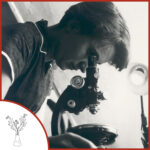

Birth: July 25, 1920
Death: April 16, 1958
Specialty: X-Ray Crystallography
Major Contributions:
Identified micro-structures in coal
Studied virus structures
X-ray diffraction images of DNA
Image: MRC Laboratory of Molecular Biology (CC BY-SA 4.0 DEED)
There has been much debate about the contributions of Dr. Rosalind Franklin to the understanding of the structure of DNA, often portraying her as either arrogant and unable to work with others or as a feminist martyr. And while that was an important part of her work – it isn’t the only thing she should be known for.
Finishing her bachelor’s degree in 1941, a year later she accepted a position as an assistant research officer at the British Coal Utilisation Research Association. While there she studied the empty spaces in coal using various methods to better determine the true density of each sample. With this information she was able to classify different coals by predicting their performance for fuel purposes and for production of war time devices. During World War II she also served as an Air Raid Warden.
Between 1950 and 53 she worked on DNA as a research associate at King’s College in London. During this time, she and Maurice Wilkins published papers about their proposed structure of DNA in the same issue of Nature as James Watson and Frances Crick.
Leaving King’s College and her work on DNA behind in 1953 she transferred to Birkbeck College where she shifted her focus to RNA and the structures of plant viruses. Two years later she published the first of many major works on the tobacco mosaic virus. Along with one her students, Kenneth Holmes, she wrote papers on TMV, cucumber virus 4, and turnip yellow mosaic virus. Invited to build a 5-foot tall model of TMV for the first international fair since WWII she worked diligently and completed the model, but passed away from cancer one day before its premier at the fair.
It was almost ten years of evidence gathering after the first publications about the helical structure of DNA, that the Nobel committee elected to award the discoverers of the structure with Nobel prizes in chemistry in 1962. As Nobels are not awarded posthumously Rosalind Franklin could not be considered, but her work played a big role in understanding the double helix DNA backbone and ultimately our understanding of the building blocks of life.
Written by Angela Goad
Sources:
Sexism in science: did Watson and Crick really steal Rosalind Franklin’s data?
DNA From the Beginning: Rosalind Franklin
See Also:
Rosalind Franklin University of Medicine and Science
A Science Odyssey: Rosalind Franklin
NOVA: Rosalind Franklin’s Legacy
Wikipedia: Tobacco Mosaic Virus
U.S. National Library of Medicine: What is DNA?
